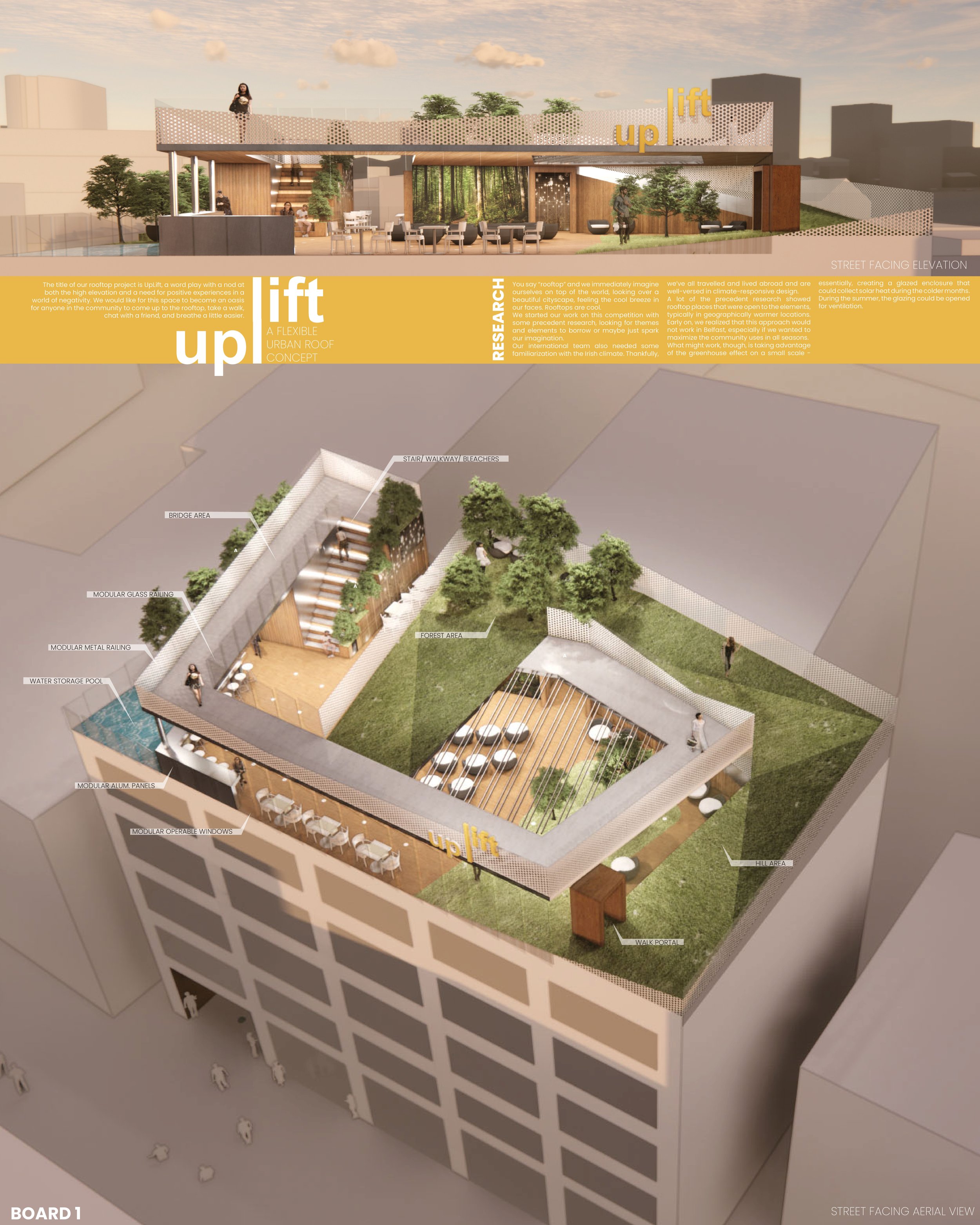UpLift: an Elevated Rooftop Concept
“UpLift” is a word play with a nod at both the high elevation and a need for positive experiences in a world of negativity. We would like for this space to become an oasis for anyone in the community to come up to the rooftop, take a walk, chat with a friend, and breathe a little easier.
This concept won the international design competition hosted by the worlds largest competition platform. Go sparks!
We welcome you to read further and imagine where a good place for it would be!
You say "rooftop" and we immediately imagine ourselves on top of the world, looking over a beautiful cityscape, feeling the cool breeze in our faces. Rooftops are cool!
We started our work on this competition with some precedent research, looking for themes and elements to borrow - or maybe just spark our imagination.
Our international team also needed some familiarization with the local climate. Thankfully, we've all travelled and lived abroad and are well-versed in climate-responsive design.
A lot of the precedent research showed rooftop places that were open to the elements, typically in geographically warmer locations. Early on, we realized that this approach would not work in colder areas, especially if we wanted to maximize the community uses in all seasons.
What might work, though, is taking advantage of the greenhouse effect on a small scale - essentially, creating a glazed enclosure that could collect solar heat during the colder months. During the summer, the glazing could be opened for ventilation.
ideation
Our initial design was born as a response to the program, calling for a multi-use public space and a café, supplemented by rooftop landscaping. The parti evolved around the idea of an embrace of the core public space by more peripheral, semi-private uses. As the idea took shape, it became a winding loop hugging the center “stage.”
As we continued sketching and “sculpting” the design in 3D, the war in Ukraine begun. Our whole team was affected by these events and weeks passed in paralyzed shock. We took a lot of walks in solitude as we pondered our places in this new world order.
We returned to the rooftop design with a sadness and quiet contemplation of the world. Our somber walks inspired the elevated slow ramp that rises above the busy common area below and offers room for uneasy feelings and difficult conversations.
program
Our approach in developing the program has been both introspective (what would we want in a space like this?) and democratic (how do we make it useful to everyone?). These two questions enabled us to squeeze a wide variety of uses into this small, overlooked rooftop:
Multi-functional common space that can be used for movie screenings, concerts, weddings, birthdays and networking events.
Café, which can become a destination – imagine saying to your friend, “Meet me at UpLift for lunch!” and enjoy the city views together, while chatting about life and pursuit of happiness.
Restrooms, which are tucked away for privacy and feature inclusive layout and a waiting area.
The Walk – a climbing, winding, elevated walkway, visible immediately after you exit the elevator to the rooftop and beckoning you to take a slow walk and ponder the world.
Multiple landscaped “hills”, which use lightweight turf and locally sourced plants.
A rainwater collection pond, with a re-circulating system, allowing the water to be used for the restroom needs and landscape irrigation in dry weather.
Storage rooms under the “hills”, a necessary support element for the common space. These will store chairs, portable stage and other equipment that will be used to turn a dancefloor into a banquet hall or lecture room.
Thanks to the presence of the elevator in most larger buildings in the US and the world, UpLift can be accessed by anyone, from young parents with strollers to wheelchair users. Once on the rooftop, all areas are accessible, including The Walk.
We envision the space to play different roles at different times of the day. For example, in the morning, adults can meet up for coffee, while watching their children run up and down The Walk or play in the central common area set up with bean bags. During the day, it could be booked for a private business event and host a small international design awards ceremony. At sunset, it could become the romantic destination, with a special table right on the edge of the building, and a couple celebrating their love while toasting the lit-up city that brought them together.
sustainability
We believe that sustainability should be an integral part of every project, not just a cutting edge thought experiment. Our design process includes the considerations of climate and sustainability at every stage. Some of the features mentioned above (greenhouse, rainwater collection, landscaping choices) came to life as a direct result of this design process. They are meant to reduce waste of resources and promote energy conservation by way of climate-responsive design. Our choice of materials also strongly favors renewable and recyclable ones, such as wood and aluminum metal panels.
In reviewing of most rooftops in the urban setting, we were struck by the glaring absence of trees. Trees are the lungs of the city, and we need to help it breathe easier. Native trees of the appropriate size will populate the UpLift planters and grow with time.
As more and more people around the world invest in their own rooftop parks, UpLift will become a network of rooftop urban parks, connecting friends and neighbors, and adding much-needed greenery to the city landscape.
Imagine a network of walkways, trees, and small public spaces embraced by the meandering paths. A network of hugs and connections, making the world just a little bit better one park at a time. This is UpLift.
If you can think of a building that may use a cool rooftop, don’t hesitate to reach out to us.
Learn more about our architecture firm here.
Sign up for our blog here.





